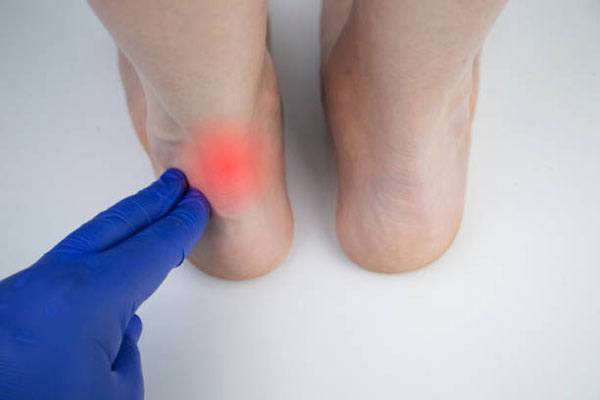Achilles Tendonitis
The Achilles tendon is the lower part of the calf muscle where it attaches to the heel bone. This muscle plays a major role in activities like walking, running, jumping, and standing on the balls of the feet. It is the largest tendon in the human body and can take up great force. However, overuse or degeneration of the tendon can lead to damage.

What is Achilles tendonitis?
Achilles tendonitis is the painful inflammation of the Achilles tendon due to continuous and intense physical activities that cause strain on the tendon. It is of the following two types, based on the part of the tendon that gets inflamed:
Non-insertional Achilles tendonitis often occurs in more active people. It results when the fibers in the middle section of the tendon break down, thicken, and swell.
Insertional Achilles tendonitis is not usually related to physical activity. It affects the lower part of the tendon when it inserts into the heel bone.
What are the symptoms of Achilles tendonitis?
The main symptoms of Achilles tendonitis include pain or discomfort and swelling in the back of the heel, especially while walking or running. These symptoms can worsen with time. Other symptoms may include:
- Tightness in the calf muscles.
- Limited range of motion while flexing the foot upwards.
- The feeling of warmth on the skin of the heel.
What are the causes and risk factors of Achilles tendonitis?
The possible causes of Achilles tendonitis include:
- Use of imperfect or worn-out shoes for running or exercising
- Use of high heels for long durations
- Running on uneven or hard surfaces
- Improper warm-up before exercising
- A quick increase in the intensity of exercises
- Premature exposure to stair climbing or hill running rather than following a scheduled exercise program
- Injury of the calf muscle, thereby increasing strain on the Achilles tendon
- Sudden and intense activities such as sprinting for the finish line
How is Achilles tendonitis diagnosed?
An accurate diagnosis by a specialist is essential to rule out other medical conditions with similar features.
Upon reviewing the symptoms, the doctor performs a physical examination of the ankle to locate the point of pain or inflammation. Further, the doctor will check if the flexibility or range of motion of the foot and ankle is impaired. The doctor might palpate the area to locate the point of severe pain and swelling.
To confirm Achilles tendonitis, the doctor might sometimes order imaging tests such as:
- X-rays to get images of the foot and leg bones
- Magnetic resonance imaging scans (MRIs) to detect ruptures and tissue degeneration
- Ultrasound scan to understand the tendon movement and related damage or inflammation
What are the treatment options?
Treatment aims at reducing swelling and relieving pain. Depending on the severity of the condition and the profession of the patient, the treatment options include:
RICE method
This is effective when used immediately after an injury. It works as follows:
Rest: Giving proper rest without putting additional strain on the tendon helps in faster healing.
Ice: Putting ice bags on the tendon for about 15-20 minutes 5-6 times a day to reduce the inflammation faster.
Compression: Wrapping bandages or athletic tapes around the tendon helps to compress the injury, prevent swelling of the tendon, and offload the tendon.
Elevation: Raising the foot above the level of the chest helps to reduce swelling.
Pain relief techniques include non-steroidal anti-inflammatory medications (NSAIDs).
Steroidal injections such as cortisone act as powerful anti-inflammatory agents that may be given around the Achilles tendon. However, due to the risk of rupture of the tendon when injected, steroids are rarely prescribed. Even when done, it should be done under the supervision of a specialist.
Surgery may be necessary if the above treatments are not effective in repairing the Achilles tendon. It is usually recommended if the condition does not improve even after 6 months of the above treatments. Based on the severity of the tendon rupture, the doctor will recommend a suitable surgical option.
Performed usually by making an incision on the tendon (cut on the skin) to access the heel bone. Through this incision, the surgeon stitches the ruptured or damaged tendon. Sometimes there is a bony eruption, which is also excised, and finally, the incision is closed. A brief period of immobilization is usually required after surgery.
Self-care
Some self-care measures that help to improve Achilles tendonitis include:
- Reducing physical activities involving the foot and ankle
- Applying ice packs to the area after exercising or in casees of pain
- Switching to less strenuous sports
- Elevating foot to reduce swelling
- Wearing shoes with a built-up heel to minimize the tension on the Achilles tendon
- Wearing a walking boot to prevent heel movement
Outcomes
Recovery depends on the severity of the Achilles tendonitis. Even with early treatment, it may take several months for the pain to resolve.
Prevention
Achilles tendonitis cannot be prevented, but the risk of developing the condition can be reduced by taking the below precautions:
- Stretching the calf muscles every day in the morning to improve performance.
- Performing varied exercises by cross-training and alternating between groups of exercise such as running and swimming.
- Gradually intensifying physical activities
- Wearing flat-heeled foot wear and choosing shoes with proper arch and cushioning support.